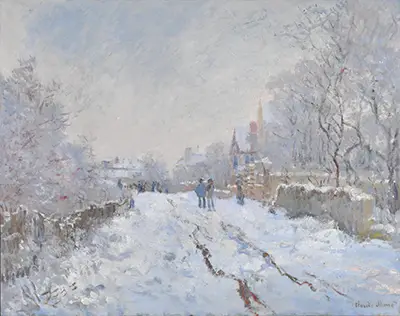He made it while staying at his home in Argenteuil during a time that it was covered in a blanket of snow – the winter of 1874 to 1875. It is one of eighteen in a series, this one being the largest.
Minute details are more present in the smaller paintings than this version. Monet rendered the larger areas of the canvas with tones of grey and blue. Upon close inspection, strokes of reds, yellow, green and dark blues help to break up the large areas of expanse. They help to bind the picture in its entirety. A feeling of disturbed snow is created on the roads in the painting – the use of paint is heavier there than on the rest of the canvas.
The majority of this series of paintings were created in several locations near his home where Monet and his family recently moved into – the boulevard Saint-Denis. The view that is seen in this particular painting of the series is what Monet could see when looking from his home toward the rue de la Voie-des-Bans. The River Seine is just out of view to the back with the local rail station behind Monet’s perspective.
The painting was sold to Théodore Duret in December 1879. Duret recalled a conversation with another artist known as Édouard Manet, reporting that Manet once wanted to capture snow in a painting. Duret showed Manet the painting that he acquired from Monet and once Manet saw it, he claimed that it was perfect and that he would not know how to do better.
He then gave up on the idea of painting snow. Snow at Argenteuil was then sold to the art dealers Boussod, Valadon et Cie, located in Paris, in 1892. In 1983, Harris Whittemore of Connecticut bought it until it was acquired by the Acquavella Galleries of New York in the 1970s. Simon Sainsbury later purchased the painting in 1973 from the Gallery. The painting remained with him until it was bequeathed in 2006 to the National Gallery in London. It remains on display to the public in the gallery to this day.
Few people are as famous in the world of art as Claude Monet is. Born 14 November 1840 in France, he was the original founder of the impressionist painting technique. He was the most prolific practitioner of the philosophy that the movement represented – the expression of an individual’s perceptions before nature. The name of the movement itself came from the title of one of his paintings – Impression, Sunrise. It was exhibited at the Salon de Paris in his independent exhibition in 1874. In an effort to truly capture the French countryside during passing seasons and changing light, Monet painted the same image several times. His most famous works include Rouen Cathedral series, Water Lilies, London Parliament series, Poplars, Haystacks and Impression, Sunrise.


